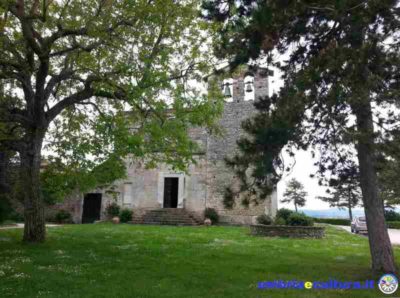The church of San Nicolò in San Gemini is part of a Benedictine complex just outside the walls of the town.
The church, dedicated to San Nicolò, was built shortly after the year one thousand, and is among the oldest, if not the oldest, of the entire region, on pre-existing buildings “adapted” for the purpose.
At first glance it looks like a church like many others, but, looking carefully, there are many details that make it unique, and particularly suggestive.
Just at the entrance, the first thing that catches the eye is the presence of a “tower”, or walls of a pre-existing building incorporated in the structure of the church; not an isolated case in Umbria, but this is certainly the oldest example.
There are three naves, but the one on the left has a non-rectilinear trend: the narrow outer wall tends to widen, then tighten again, the rhythm dictated then by the columns and pillars is not specular between the right and left row.
Even the capitals do not escape this particular law: the oldest, with human figures, is certainly material from the late Roman era, the others, however, are coeval with the arrangement of the church.
Even if we do not realize it, the facade is oblique with respect to the axis of the church and, going along the nave to the end, the remains of a pre-existing hemispherical apse inside the current square are visible.
Unfortunately, the San Nicolò complex has gone through alternating fortunes. It reached its peak between 1000 and 1200, and after an inexorable decline, in 1500 it was already in total abandonment.
The right wall, part of the facade and the roof collapsed. The portal was removed and sold to an antique dealer and now it shows off in the Metropolitan Museum in New York, what we see here is a faithful copy of it. The floor was invaded by grass and the frescoes that decorated it, exposed for centuries to the elements, were inexorably lost forever.
All that remains of them is a few fragments, a Madonna and Child signed by Ruggero da Todi and a San Gregorio Magno.
Only in the 1960s was the site purchased by the Violati family and totally recovered. The rooms of the monastery cannot be visited because they are used as a dwelling.
Despite the changing fortunes, the charm of the site is unquestionable, more than a thousand years of history confer an atmosphere that reigns and that involves the visitor. Already from the outside the signs of its history are legible, from the string course of the non-aligned facade, a sign of a landslide, to small details such as the “owls” incorporated in the walls.
Finding all these little details will be a pleasant treasure hunt for the visitor, on a journey back in history.
Benedetta Tintillini
Find the church of San Nicolò on Google Maps:


